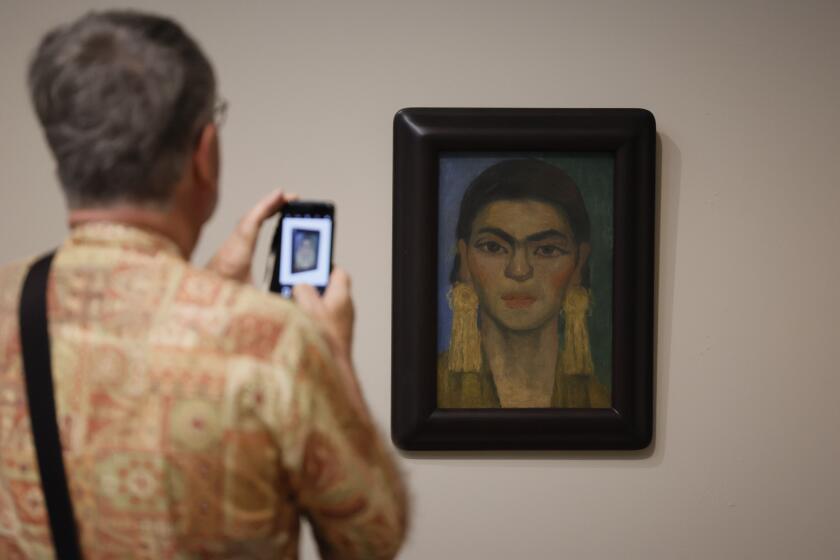Walking Hot Rods
Bill Gates lives in them, Run-DMC raps about them, and Tiger Woods gets paid megabucks to wear them. Athletic shoes--studies in rubber, leather and mesh--have transcended their function in sports, clothing and commerce to become design objects fit for a new exhibit at the San Francisco Museum of Modern Art.
The show, believed to be the first devoted to sneaker design, provides an illuminating look at the process involved in creating something as seemingly simple as a shoe. Delineating components like air cushions, arch supports and foam wedges, sneaker designers have become architects for the feet. And the future is even more intriguing, with the prospect of shoes with “sole cams,” video cameras in the heel.
“This show is not just about how hip and cool sneakers are. If you take these shoes and put them under a spotlight, you realize what amazingly beautiful, strange, weird objects they are. Many of the lessons we learn from looking at great paintings and sculptures we can also find in something much more accessible,” said Aaron Betsky, the museum’s design curator who conceived “Design Afoot: Athletic Shoes, 1995-2000,” with Steven Skov Holt, a vice president at a Sunnyvale, Calif.-based creative studio called Frogdesign.
The museum, which opened in its current location in 1995, has earned a reputation for producing offbeat shows such as “Far Out Bay Area Art, 1968-71,” which featured the psychedelic rock and roll posters and crocheted clothing of the hippie generation, and “Wild Design,” which explored the aesthetic qualities of camping equipment. Although the display resembles a shoe store more than a gallery, the 150 pairs of sneakers are nevertheless visually arresting.
Orange and white stripes zigzag down the sides of Converse’s 1996 Voltage high-top like bolts of lightning. Dolce & Gabbana’s baroque metallic gold sneaker, encrusted in rhinestones, breaches the divide between fashion and athletic footwear. New Balance’s classic Cushioning sneaker embodies a combination of electric orange, yellow and red synthetic suede that creates a visual candy. The easy curves of Gucci’s supple leather Velcro Sport Shoe are as sensually suggestive as those on a sports car. And the molded black rubber sole of Oakley’s Flesh Sandal is executed with the same care as the sinuous tendons and muscles in a Greek sculpture.
The examples make you want to see more, but the exhibit, which opened Saturday, is deliberately limited in scope. “The past five years represent a golden age in sneaker design, akin to the late 1950s and early 1960s in automotive design,” said Holt. “Sneakers are the hot rods of the year 2000” because they now come a range of forms, colors, materials and options. And prices, need we add, can run as high as $200.
Like cars, sneakers are a huge business ($13.7 billion last year) and are designed to make an impression while they are in motion. “I think of them as dynamic sculptures,” said John Hoke III, a former design assistant to architect Michael Graves. Hoke, who now works as one of Nike’s 50 footwear designers in Beaverton, Ore., said his design challenge is to create a sneaker that can respond to specific athletic requirements and look sharp.
Inspiration, he said, can come from anything--cars, movies, nature, rocket ships or buildings. Trained as an architect, Hoke said there is a difference between designing structures and designing sneakers. “In architecture, every time you get a new project, you have a new site. When you design sneakers, it’s the same site, but you are able to learn from the past.”
The introduction of Nike’s first Air Jordan in 1985 represented a turning point in sneaker history, because of the public frenzy over the red and black high-tops. “This demand was created around a commodity that was previously dull,” said Holt. No doubt Michael Jordan’s celebrity helped, too. Nike designer Tinker Hatfield has become a celebrity himself in design circles for creating all but two of 15 versions of the Air Jordan.
Mind-blowing sneaker designs together with fast-moving images on the Internet, MTV and in video games, have made today’s youth more visually literate. They would never be satisfied with the Converse Jack Purcells and Chuck Taylors, popular in the 1950s and 60s.
Computers have changed sneaker designing, like other artistic disciplines,, Hoke said. Using computers, designers can translate hand sketches into models at record speed, dictating within one-hundredth of an inch where a logo, an eyelet or an air cushion will be on a shoe.
The technological ease allows a giant like Nike to come up with about 500 new designs (for men, women and children) a year and allows smaller companies to compete. Acupuncture, a small London label, has several shoes featured in the show, including the Suki Saki, a wonderful black nylon shoe with a sketch of a geisha on the side and an imprint of a geisha on the sole.
Trends in sneaker design in the last five years have reflected lifestyle trends. Reebok’s Kingpin, a grenade-like quilted leather high-top with a pull-tab on the heel, exemplifies the same “urban warfare trend” that has put legions of SUVs on the road. “It’s the sense that when you are going out on the streets, you are going into the wild, concrete jungle,” Betsky said.
The popularity of minimalism and simplicity--a trend that gave birth to magazines such as Real Simple and Simplicity--is reflected in the clean but graceful lines of the 1999 Air Jordan XV, which resembles a sleek cruise liner. Betsky describes the design as “an abstraction of the foot.”
Some designers take the classic retro approach, used so successfully by Volkswagen in updating its Bug. Prada’s leather boat shoes with sculpted rubber soles were first produced for its America’s Cup team in 1995 and later offered to the retail market. “Prada began riffing on the idea of the boat shoe and the loafer, saying, ‘There’s no reason why they can’t have the same comfort and response to the pavement as a sneaker,”’ Betsky said. The Italian fashion design house created sneakers with high-heels and a pair that resemble bowling shoes.
Design techniques used in sneakers have also influenced other products. Beginning with Nike’s Air Max in 1995, designers have constructed shoes so that separate components like air cushions and arch supports are very clearly delineated. “People love to be able to point to each piece and say how it works,” Betsky said.
Now, tech companies are trying it too. Holt said even Apple, whose original iMac has become a design icon, recently began selling a clear version that lets consumers peer inside a computer’s mind.
Customization will be the next big thing in sneaker design, the curators predict. Nike’s Presto is made of a special mesh that molds to fit each individual foot. And if the Presto is not personal enough, there’s a Web site where computer users can design their own sneakers, https://www.customatix.com.
The automotive industry is going in a similar direction; Holt said his firm recently designed a prototype for Ford Motors for an electric car with a horn that can be customized with a greeting, a voice, even a cat’s meow. (Should make traffic sound interesting.)
Others believe shoes of the future will be imbued with “holistic” features. A concept shoe created by Holt’s Frogdesign for the exhibit has an insole that incorporates principles of reflexology, shiatsu massage and acupressure.
New York-based designer Karim Rashid, who has designed more than 200 objects for Issey Miyake, Black & Decker, Sony and others, sketched the prototype “sole cam” sneaker with the video camera embedded in the heel. “You can shoot the scenery behind you and have it Web-cast in real time on the Internet, so a relative can see where you are on vacation,” said Rashid. “There’s also the practical application: safety.”
In the meantime, the enthusiasm for collecting sneakers for their design elements is growing. “When I told Tinker Hatfield several years ago that his designs were going to be collectible someday, he laughed,” Holt said. “But what we have seen lately is Internet bulletin boards, particularly in Japan and England, where people are offering to pay hundreds of dollars for particular shoes in particular colors--shoes that will never be worn but will be celebrated.”
* “Design Afoot: Athletic Shoes 1995-2000” runs through Oct. 17 at the San Francisco Museum of Modern Art.
*
* Booth Moore can be reached at Booth.Moore@latimes.com.
(BEGIN TEXT OF INFOBOX / INFOGRAPHIC)
Godfathers of Sole
1836: U.S. inventor Charles Goodyear receives patent for vulcanized rubber
1870: Word “sneak” defined by American lexicographer as “shoes with canvas tops and India rubber soles”
1895: Joseph Foster founds Reebok in England
1906: New Balance Arch & Support Co. founded in Boston
1916: U.S. Rubber Co. produces Keds (mixture of “kids” and “ped”)
1917: Converse Rubber Co. produces first “All-Star”
1920: Duke of Windsor spurs tennis shoe craze during U.S. visit
1924: British Olympic “Chariots of Fire” runners outfitted by Reebok
1950: Ventilating eyelets on sneaker sides introduced
1962: New Balance introduces first wedge-heeled running shoe.
1985: Nike releases first Air Jordan shoe
1991: Reebok debuts the $170 “pump” shoe; L.A. Gear releases Lights sneakers with glowing red lights in the rear.
*
Source: “The Sneaker Book: Anatomy of an Industry and an Icon,” by Tom Vanderbilt (New Press, 1998).
More to Read
The biggest entertainment stories
Get our big stories about Hollywood, film, television, music, arts, culture and more right in your inbox as soon as they publish.
You may occasionally receive promotional content from the Los Angeles Times.







